Welcoming a New Life
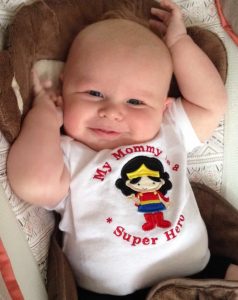
On April 8, 2013, Lee Conner stood beside his wife, Emily, in the delivery room. He held her hand and supported her as they welcomed their third child, James, into the world. As a new life was being born, Lee looked out the hospital window and noticed the helicopter leaving the Alamance Regional helipad in Burlington, NC. As its propellers were pulling it high into the sky, he couldn’t help but wonder if the aircraft was heading to UNC Hospital in Chapel Hill, where Lee had fought for his life after a similar helicopter ride only a few months before.
An Intense Strain of the Flu
On Sunday, December 30th, 2012, Lee was starting to feel unwell. He’d felt fine the day before, when he went to the Dean Dome to cheer on the Tar Heels with his daughter, Caroline, and her grandfathers for their annual holiday basketball game. Over the next 24 hours, his symptoms worsened, including shortness of breath, a fever, sore throat, and fatigue. Lee headed to urgent care late in the morning on the 31st, hours before the ball was set to drop on a new year. They immediately sent him to the emergency room at Alamance Regional Medical Center (ARMC).
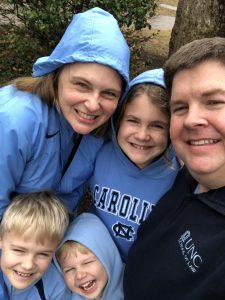 Lee was at ARMC for about 18 hours as his condition continued to deteriorate. Doctors intubated him, a process of inserting a tube, called an endotracheal tube, through the mouth and then into the airway, so he could be placed on a ventilator to help him breathe. Despite being intubated, Lee’s condition continued declining precipitously. He doesn’t remember the next ten days, relying instead on stories and recollections of family, friends, and the doctors and nurses who surrounded him during his time of need.
Lee was at ARMC for about 18 hours as his condition continued to deteriorate. Doctors intubated him, a process of inserting a tube, called an endotracheal tube, through the mouth and then into the airway, so he could be placed on a ventilator to help him breathe. Despite being intubated, Lee’s condition continued declining precipitously. He doesn’t remember the next ten days, relying instead on stories and recollections of family, friends, and the doctors and nurses who surrounded him during his time of need.
“I was unconscious during all of this, but I know that everyone involved, particularly my father-in-law, a physician, and my best friend, Ryan, who’s an EMT, were advocating that I needed to go somewhere with greater resources. My oxygen level had dropped to the point where it was getting very critical very quickly,” recounts Lee. Around 4am on January 1st, 2013, Lee was airlifted to UNC Hospital in Chapel Hill. “My family drove in the middle of the night from Burlington to Chapel Hill, about a 30-minute trip. It probably gives you an idea of how critical I was that, instead of a 30-minute ambulance ride, they thought the helicopter was necessary.”
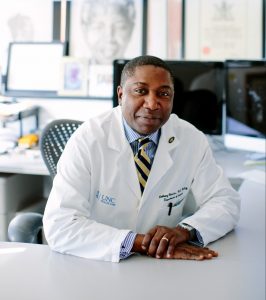
Dr. Anthony Charles, Oliver R. Rowe Distinguished Professor, Chief of General and Acute Care Surgery, and the Director of Adult ECMO Program, met Lee when he arrived at UNC Medical Center. He evaluated Lee’s condition; his diagnosis was influenza A, a severe strain of the flu, coupled with Strep pyogenes pneumonia. As soon as Lee’s family arrived, he talked with them about what needed to happen.
Dr. Charles explained to the family that Lee’s lungs were struggling. He recommended putting Lee on extracorporeal membrane oxygenation (ECMO), a machine similar to the heart-lung by-pass machine used in open-heart surgery. It pumps and oxygenates a patient’s blood outside the body, allowing the heart and lungs to rest. Dr. Charles was kind but clear that if Lee wasn’t put on ECMO, he had a 10% chance of survival or less. On ECMO, Lee’s chances for survival were still only a coin flip, about 50%, but the choice was clear for Emily, who didn’t hesitate and gave Dr. Charles and his team permission to put Lee on ECMO.
“One of the things that both my father-in-law and Ryan, both medical providers, commented on,” said Lee, “was how good Dr. Charles was at talking with the family and laying everything out to them in a very honest and candid way, but also communicating in a way that gave everyone comfort and confidence that I was receiving the best possible treatment.”
The ECMO machine pumps and oxygenates a patient’s blood outside the body, allowing the heart and lungs to rest. When you are connected to ECMO, blood flows through tubing to an artificial lung in the machine that adds oxygen and takes out carbon dioxide; then the blood is warmed to body temperature and pumped back into your body.
“Being placed on ECMO requires a surgical procedure but it is usually done in a patient’s room,” explains Dr. Charles. “The patient is sedated and given pain medication and an anti-coagulant to minimize blood clotting. A surgeon, assisted by an operating room team, inserts the ECMO catheters into either an artery or veins. An x-ray is then taken to ensure the tubes are in the right place. Usually, a patient on the ECMO pump will also be on a ventilator, which helps the lungs to heal. While on ECMO, the patient will be monitored by specially trained nurses and respiratory therapists, as well as the surgeon and surgical team. Since Lee’s experience eight years ago, the machines are a lot smaller, more efficient, and safer.”
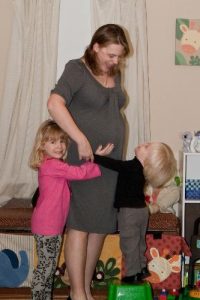 Lee remained unconscious for ten days in the surgical ICU. During that time, a nurse stayed with him in his room at all times. Dr. Charles, the nursing team, and the Infectious Diseases team monitored his condition constantly to ensure that Lee’s lungs were recovering. Emily stayed by her husband’s side throughout the ordeal, seven months pregnant with a four-year-old (Caroline) and a two-year-old (Henry) at home, waiting and praying for Lee to recover.
Lee remained unconscious for ten days in the surgical ICU. During that time, a nurse stayed with him in his room at all times. Dr. Charles, the nursing team, and the Infectious Diseases team monitored his condition constantly to ensure that Lee’s lungs were recovering. Emily stayed by her husband’s side throughout the ordeal, seven months pregnant with a four-year-old (Caroline) and a two-year-old (Henry) at home, waiting and praying for Lee to recover.
On their Caring Bridge page, Emily described Lee: “It’s hard to sum Lee up in just a few words, but to those that know and love him, it’s easy to say he’s an extraordinary man as a husband, father, son and friend with the heart of a bulldog. It’s a bit cheesy to say, but he’s our superhero.”
Waking Up to a New World and a New Year
After ten days on ECMO, Dr. Charles determined that Lee was ready and began tapering his sedation to allow him to regain consciousness, a process that took a few days before Lee was fully alert. Lee described waking up as a “bizarre experience because I missed nearly two weeks of my life. That time is something that my wife, my friends, and family will never forget, but I don’t remember. Our family’s world was a lot different when I woke up in many ways. For example, we were under contract to buy a house, but Emily cancelled that because she didn’t know if I would make it. More importantly, Emily was seven months pregnant with our third child. The first things I wanted to know once I oriented myself were: How’s Emily doing? How’s the baby? Are Caroline and Henry doing ok?”
“Everyone else around us, our extended family, all our friends, they’d all had this experience of being terrified and not knowing what was going to happen with me and whether Emily was going to have to raise our three kids by herself. I hadn’t experienced any of that. That was very strange; people having this experience where I was at the center of it, but I didn’t participate in it, mentally speaking, and I couldn’t even recall it.”
Waking up from heavy sedation is not like waking up from regular sleep. Lee awoke slowly over a couple of days. With ECMO patients, they must be medicated and strapped down to the bed so that their movements don’t interrupt the machine. The medication caused Lee to have no memory of the experience. Lying unmoving on a hospital bed for ten days meant that Lee’s muscles atrophied, so he couldn’t get up and walk on his own right away. As a part of the transition off of ECMO, Lee received a tracheotomy, a procedure in which doctors surgically cut the front of his neck, opening a direct airway into his windpipe, which also needed time to heal and meant that he couldn’t talk. The muscle atrophy also meant he couldn’t even hold a pen to write, so communication was more like a game of charades at first. When he went to the hospital, he was a regular 38-year-old, but when he woke up, he couldn’t walk, couldn’t talk, couldn’t write, and had to relearn all those skills.
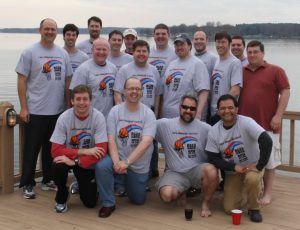
Over the next couple of days after waking up, Lee was flooded with visitors. He attended UNC as an undergrad and then returned to the university to obtain his law degree and MBA. With so many ties to Chapel Hill, Lee saw many friends who came by to check on him. Their words really drove home how severe his situation had been. “The people coming in to see me were just so happy that I was alive, which felt odd at first to a relatively healthy 38-year-old person. It took a day or two for me to process how close to the edge I had gotten. Everybody else understood that really well because they’d experienced it in real-time, but it took a little bit for everything to really sink in on me. It was an overwhelming feeling to meet Dr. Charles and his team for the first time, knowing that they had saved my life. Waking up was just a very surreal experience, in many ways.”
Recovery and Rehabilitation
After Lee was strong enough, the doctors transferred him out of the surgical ICU to the rehabilitation unit. Being so immobile for so long forced Lee to learn how to walk again. “I certainly wasn’t used to being unable to stand up and walk,” said Lee. “I didn’t believe it at first. They had to put me on my feet and show me that I really couldn’t stand up and that I was going to have to put in work before I could walk again.”

The rehab team worked with Lee daily to help him get back to his normal function. “The rehab unit was great,” recalls Lee. “They were used to working with folks like me. They made it a very comfortable experience – people looked after me, the room I was in was much more comfortable than a typical hospital room, and it was easy for my friends and family to come to see me. They also helped me set reasonable expectations for myself. So much changed while I was completely out of it for two weeks, it took me a while to mentally adjust to where I was physically at that moment and process what I needed to do to get back to normal.”
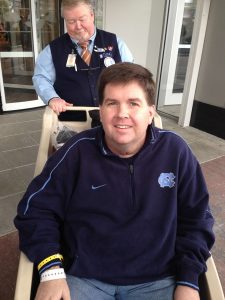 After two weeks in the rehab unit, Lee was ready to head home. Before leaving the hospital, he asked Dr. Charles about his diagnosis and whether he would have long-term effects from his condition. Dr. Charles assured Lee that there was no reason to believe that the situation would repeat itself. The team performed multiple tests and couldn’t find anything that indicated that he had a particular vulnerability that was likely to be exploited again. Unfortunately, Lee contracted a particularly deadly strain of the flu, and combined with the Strep, it was a nearly fatal cocktail that Lee was barely able to survive.
After two weeks in the rehab unit, Lee was ready to head home. Before leaving the hospital, he asked Dr. Charles about his diagnosis and whether he would have long-term effects from his condition. Dr. Charles assured Lee that there was no reason to believe that the situation would repeat itself. The team performed multiple tests and couldn’t find anything that indicated that he had a particular vulnerability that was likely to be exploited again. Unfortunately, Lee contracted a particularly deadly strain of the flu, and combined with the Strep, it was a nearly fatal cocktail that Lee was barely able to survive.
“I got the flu shot that year,” said Lee. “Lots of people ask me that. I get it every year, still do. It’s the right thing to do, but it’s impossible for it to cover every strain of “the flu”. Each year scientists design a vaccine against what they believe will be the most prevalent strains of the virus. I just drew the short straw and got a rare and particularly potent strain. It was just bad luck. That said, it’s hard to go through something like I did and not feel a little more vulnerable than you did before it happened.”
“For most people, the Flu will be mild and they will recover rather quickly, others may get sick, requiring hospitalization and very few will require ECMO,” says Dr. Charles “The outcome for COVID-19 is worse.”
Celebrating His Discharge
Lee was discharged on January 28th, 2013, four weeks after taking a helicopter ride to UNC Medical Center. On the way out of the hospital, he and Emily stopped by the ICU one last time to thank the ECMO team for all they did for him during his stay, beginning an annual tradition.
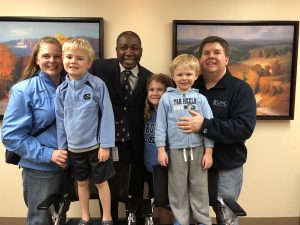 Each year on January 28th, Lee and Emily drive over to Chapel Hill and bring a basket of food and snacks to thank Dr. Charles and the ECMO team and remind them of the incredible impact of their work. In 2018, they took Caroline, Henry, and James with them for the first time to meet Dr. Charles, the doctor who saved their dad. Due to COVID, this past January was the first time in eight years that they didn’t make the trip, but Lee and his family look forward to continuing the tradition next year.
Each year on January 28th, Lee and Emily drive over to Chapel Hill and bring a basket of food and snacks to thank Dr. Charles and the ECMO team and remind them of the incredible impact of their work. In 2018, they took Caroline, Henry, and James with them for the first time to meet Dr. Charles, the doctor who saved their dad. Due to COVID, this past January was the first time in eight years that they didn’t make the trip, but Lee and his family look forward to continuing the tradition next year.
“Dr. Charles and I have stayed in touch since I got off of ECMO, and we’ve gotten to know each other,” Lee shared. “He is an amazing person and an incredible contributor to UNC. As an alumnus, I’m really proud that he’s a Tar Heel.”
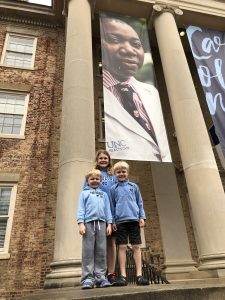 Lee continued, “I tell people that I owe a lot to Carolina. I met Emily while we were at UNC and later proposed to her under the Davie Poplar; I earned three degrees there; I made some of the best memories of my life there; and when I needed Carolina the most, Dr. Charles and the ECMO team saved my life in Chapel Hill. I wouldn’t be here right now without them. ECMO can be intimidating because it is so intense and so invasive, but it saved my life. I don’t think there’s any question about that.”
Lee continued, “I tell people that I owe a lot to Carolina. I met Emily while we were at UNC and later proposed to her under the Davie Poplar; I earned three degrees there; I made some of the best memories of my life there; and when I needed Carolina the most, Dr. Charles and the ECMO team saved my life in Chapel Hill. I wouldn’t be here right now without them. ECMO can be intimidating because it is so intense and so invasive, but it saved my life. I don’t think there’s any question about that.”
